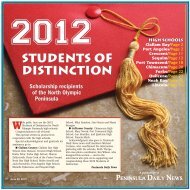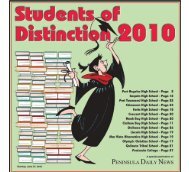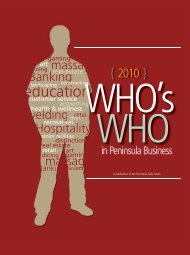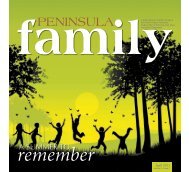Create successful ePaper yourself
Turn your PDF publications into a flip-book with our unique Google optimized e-Paper software.
“This garden has hosted families with young<br />
children who have had as much fun playing in<br />
the dirt as their parents have had growing food<br />
for the dinner table,” says Marilyn Harbough,<br />
another of PAVG’s founders.<br />
Beginning gardeners, uncomfortable with<br />
taking on plots alone, have partnered with others<br />
to share the experience and share the harvest,<br />
she says while adding that, “as a bonus to<br />
growing great vegetables, they have grown<br />
great friendships.”<br />
Marilyn says that children and teachers<br />
from BoBaggins Daycare and Learning Center<br />
have been digging, planting, laughing, playing<br />
and bringing smiles to the faces of fellow gardeners<br />
at Vineyard over the years.<br />
Although there are many gardeners who<br />
have been tending their plots since the garden’s<br />
inception in 2009, Marilyn says several others<br />
participated in a community garden project to<br />
learn gardening basics so they could then cultivate<br />
garden space at home.<br />
Since the beginning, some plots have been<br />
maintained for charitable donations, but in 2011,<br />
the Vineyard Garden had a larger-than-usual<br />
excess of available plots which were planted or<br />
seeded with donations from local garden centers<br />
and tended by Vineyard’s own gardeners, with<br />
help from community-service workers under the<br />
supervision of gardener Bob Shaffer.<br />
“Through his commitment and hard work, we<br />
were able to deliver hundreds of pounds of<br />
fresh, nutritional, organically grown produce to<br />
the Port Angeles Food Bank,” Marilyn says.<br />
Marilyn describes the Fifth Street gardeners<br />
as “a wonderful mix of people.”<br />
Among that mix last year, the garden’s first,<br />
were preschool children from the adjacent First<br />
Step Family Support Center and a group of<br />
nearby office workers who collectively gardened<br />
two plots during their lunch hours.<br />
She says one man framed his plots with an<br />
innovative moveable greenhouse cover, all the<br />
while offering his elderly mother a peaceful<br />
place to gather plentiful dandelion greens<br />
already growing in the garden.<br />
“A mother and her 10-year-old son actually<br />
grew corn to maturity during last summer’s cool<br />
weather; an experienced, creative gardener<br />
amazed everyone with ripe tomatoes in July; a<br />
local carpenter raised a healthy harvest and<br />
contributed his expertise to garden construction<br />
projects,” Marilyn says.<br />
One of Fifth Street’s senior gardeners was<br />
able to comfortably garden in raised beds<br />
designed and built by the architect of both of<br />
the community gardens, Hank Gibson.<br />
Plots were also set aside and tended to<br />
deliver produce to the Port Angeles Food Bank<br />
plus supervised community-service workers provided<br />
many hours of labor toward maintaining<br />
the garden.<br />
These gardens are green spaces, and not<br />
only provide plants that produce air and food,<br />
but also serve as inflow points for rainwater<br />
helping the city minimize its combined sewer<br />
overflow problem, says Port Angeles City<br />
Councilman Max Mania.<br />
“Allowing rain water direct access to soil is the<br />
best way to address our overflow issues,” he says.<br />
“I’d also argue that gardens are aesthetically<br />
much, much more pleasing than almost any<br />
other form of ‘development’ on any given plot of<br />
land, and thus add to the value of the homes<br />
and properties near them.”<br />
The gardens give the community a place to<br />
interact and provide a means for social service<br />
organizations to grow or harvest foods for local<br />
low-income residents.<br />
In its simplest form, Jill sees community gardens<br />
as a place where people come together and<br />
grow food — the most basic human need.<br />
“At a time when it is difficult to figure out<br />
exactly where our food comes from — let alone<br />
how its grown or what chemicals and gunk are<br />
used to grow it — it’s empowering to be able to<br />
grow it ourselves,” she says<br />
Although North Olympic <strong>Peninsula</strong> residents<br />
are lucky enough to have a thriving community<br />
of local farmers that offer a bounty of the best<br />
produce available, Jill says the ability to grow<br />
your own food is just one more way to make the<br />
area a healthy and self-sustaining place.<br />
Not to mention that growing your own<br />
organic produce for $35 a year is great for the<br />
pocketbook.<br />
Metaphorically, Jill says that people involved<br />
with PAVG are growing community.<br />
“As a recent transplant, I found it a bit difficult<br />
to meet people in Port Angeles. It’s amazing<br />
what connections can be made with hands in<br />
the dirt or in a discussion about the best way to<br />
use all of that kale!” she says. “Working with<br />
others to create a beautiful space makes you<br />
feel like part of something bigger.”<br />
Getting involved<br />
Both gardens are welcoming new gardeners.<br />
Plots are currently available for the 2012 growing<br />
season.<br />
Details and information can be found online<br />
at www.pavictorygardens.org or by calling Robin<br />
Gibson at 360-457-3744 for the Vineyard Community<br />
Garden; or John Danks at 360-809-3301<br />
for the Fifth Street Community Garden.<br />
Each gardener is expected to give eight hours<br />
of volunteer work in communal areas around th<br />
garden per year. Gardeners receive water, access<br />
to tools and gardening classes once a month.<br />
— STORY BY JENNIFER VENEKLASEN<br />
COGS photo by Pam Larsen.<br />
SUSTAINABLE LIVING<br />
sequim gardens<br />
There are two Community Organic Gardens of Sequim (COGS).<br />
The Fir Street Garden is located in a field behind St. Luke’s<br />
Episcopal Church, 525 N. Fifth Ave.<br />
The June Robinson Memorial Garden is located on the corner of<br />
Sunnyside Avenue and Spruce Street.<br />
Each garden features numerous in-ground 10-foot plots and 4-foot<br />
by 8-foot raised beds that community members can lease for $45 per<br />
year to grow organic vegetables, herbs, berries, fruits and flowers.<br />
The fee includes organic gardening classes, access to tools,<br />
water and garden supplies and a variety of seeds.<br />
Organic gardening practices must be used.<br />
Some community work hours to help keep community areas of<br />
both gardens well-tended are required.<br />
“After four years, the Fir Street Garden has become a wonderful<br />
and unique gardening community,” says organizer Liz Harper.<br />
Many of the gardeners have had their plots or raised beds for<br />
several years and feel a real sense of community with the garden.<br />
“Gardeners take excellent care of the community areas as well<br />
as their own plots,” Liz says. “They often share recipes and gardening<br />
stories, meet at the garden to work on their plots or have lunch<br />
and feel the garden has had a positive and sometimes profound<br />
effect on their lives.”<br />
At time of publication, there were three plots left at the Fir<br />
Street Garden and five plots and four raised beds at the June<br />
Robinson Memorial Garden.<br />
People interested in a plot or raised bed at the Fir Street<br />
Garden should phone Liz at 360-683-7698, and those who want a<br />
plot at the Spruce Street location should phone Anne Holgerson<br />
at 360-683-4139.<br />
Gardening classes<br />
Classes are free with community garden plots, but they’re also<br />
offered to people who want to grow their food at home for just $30.<br />
Classes will be taught by Pam Larsen, a COGS founder and<br />
experienced organic gardener.<br />
“It seems there’s ever more interest in healthy food and the surest<br />
and least expensive way to get what you want it is to grow it<br />
and to grow it without chemicals,” she says.<br />
Classes will be from 10 a.m. to noon for 10 consecutive Saturdays<br />
beginning March 10.<br />
People will get the basics for a successful first year garden,<br />
grown without chemicals. In addition participants will tour two<br />
organic gardens so they can see the different ways people approach<br />
growing organic food.<br />
Those interested in classes should phone Pam at 360-582-1106.<br />
PENINSULADAILYNEWS.COM | HEALTHY LIVING | MARCH 2012 7












